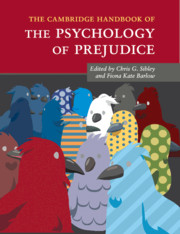Book contents
- Frontmatter
- Dedication
- Contents
- List of Figures
- List of Tables
- Notes on the Contributors
- Part I General Theoretical Perspectives
- Part II Prejudice in Specific Domains
- Part III Prejudice Reduction and Analysis in Applied Contexts
- 20 Recent Developments in Intergroup Contact Research: Affective Processes, Group Status, and Contact Valence
- 21 From Prejudice Reduction to Collective Action: Two Psychological Models of Social Change (and How to Reconcile Them)
- 22 Self-Regulation Strategies for Combatting Prejudice
- 23 Antecedents and Consequences of Evaluative Concerns Experienced During Intergroup Interaction: When and How Does Group Status Matter?
- 24 Stereotypicality Biases and the Criminal Justice System
- 25 Prejudice, Stigma, Bias, Discrimination, and Health
- 26 Development of Delegitimization and Animosity in the Context of Intractable Conflict
- 27 Interventions in Real-World Settings: Using Media to Overcome Prejudice and Promote Intergroup Reconciliation in Central Africa
- 28 Identification with All Humanity: The Antithesis of Prejudice, and More
- 29 It's All About Ignorance: Reflections from the Blue-eyed/Brown-eyed Exercise
- Index
- References
25 - Prejudice, Stigma, Bias, Discrimination, and Health
from Part III - Prejudice Reduction and Analysis in Applied Contexts
Published online by Cambridge University Press: 17 November 2016
- Frontmatter
- Dedication
- Contents
- List of Figures
- List of Tables
- Notes on the Contributors
- Part I General Theoretical Perspectives
- Part II Prejudice in Specific Domains
- Part III Prejudice Reduction and Analysis in Applied Contexts
- 20 Recent Developments in Intergroup Contact Research: Affective Processes, Group Status, and Contact Valence
- 21 From Prejudice Reduction to Collective Action: Two Psychological Models of Social Change (and How to Reconcile Them)
- 22 Self-Regulation Strategies for Combatting Prejudice
- 23 Antecedents and Consequences of Evaluative Concerns Experienced During Intergroup Interaction: When and How Does Group Status Matter?
- 24 Stereotypicality Biases and the Criminal Justice System
- 25 Prejudice, Stigma, Bias, Discrimination, and Health
- 26 Development of Delegitimization and Animosity in the Context of Intractable Conflict
- 27 Interventions in Real-World Settings: Using Media to Overcome Prejudice and Promote Intergroup Reconciliation in Central Africa
- 28 Identification with All Humanity: The Antithesis of Prejudice, and More
- 29 It's All About Ignorance: Reflections from the Blue-eyed/Brown-eyed Exercise
- Index
- References
Summary
Operationalizing Prejudice, Stigma, Bias, and Discrimination in Health Research
Prejudice, stigma, bias, and discrimination are all expressions of oppression, “a concept that describes a relationship between groups or categories of people in which a dominant group benefits from the systematic abuse, exploitation, and injustice directed toward a subordinate group” (Johnson, 2000, p. 293). While a myriad of typologies exist concerning definitions and manifestations of prejudice, stigma, bias, and discrimination, in the public health literature, oppression is frequently conceptualized across three distinct, but interrelated, levels (Jones, 2000; Paradies, 2006):
• internalized (or intrapersonal) prejudiced attitudes or beliefs, frequently based on notions of supposedly innate superiority/inferiority, which may be subscribed to either by members of dominant social groups or by subordinate ones;
• interpersonal discriminatory interactions between people, with varying degrees of frequency and intensity, including manifestations from racially motivated assault to verbal abuse, ostracism, and exclusion; and
• systemic or structural, which includes bias in societal institutions, laws, policies, and social practices. Of note, this level may be thought of as the one that sets the context and increases or decreases the likelihood of the first two types of oppression outlined here.
In the mid-twentieth century, the psychological concept of prejudice (Allport, 1954) and the sociological phenomenon of stigma (Goffman, 1963) gave rise to two lines of inquiry, which have only recently begun to converge in relation to their use within health research (Phelan, Link, & Dovidio, 2008), with ongoing calls to better understand the relationship between these concepts (Hatzenbuehler & Link, 2014; Hatzenbuehler, Phelan, & Link, 2013; Stuber, Meyer, & Link, 2008). For example, a stigma framework has often been referenced when studying specific illnesses or morbidities, such as mental illness and HIV/AIDS, while prejudice and discrimination have been foregrounded in studies of racism and health. In addition, the concept of bias is commonly utilized within health care contexts as a way of describing unconscious forms of discrimination, often labeled implicit bias (Paradies, Truong, & Priest, 2014; Shavers et al., 2012; Van Ryn et al., 2011). Within public health, researchers have tended to define and measure discrimination as the behavioral manifestations of prejudice, stigma, and bias, thus considering discrimination a real-world manifestation of oppression with potential adverse health consequences.
- Type
- Chapter
- Information
- The Cambridge Handbook of the Psychology of Prejudice , pp. 559 - 581Publisher: Cambridge University PressPrint publication year: 2016
References
- 7
- Cited by



